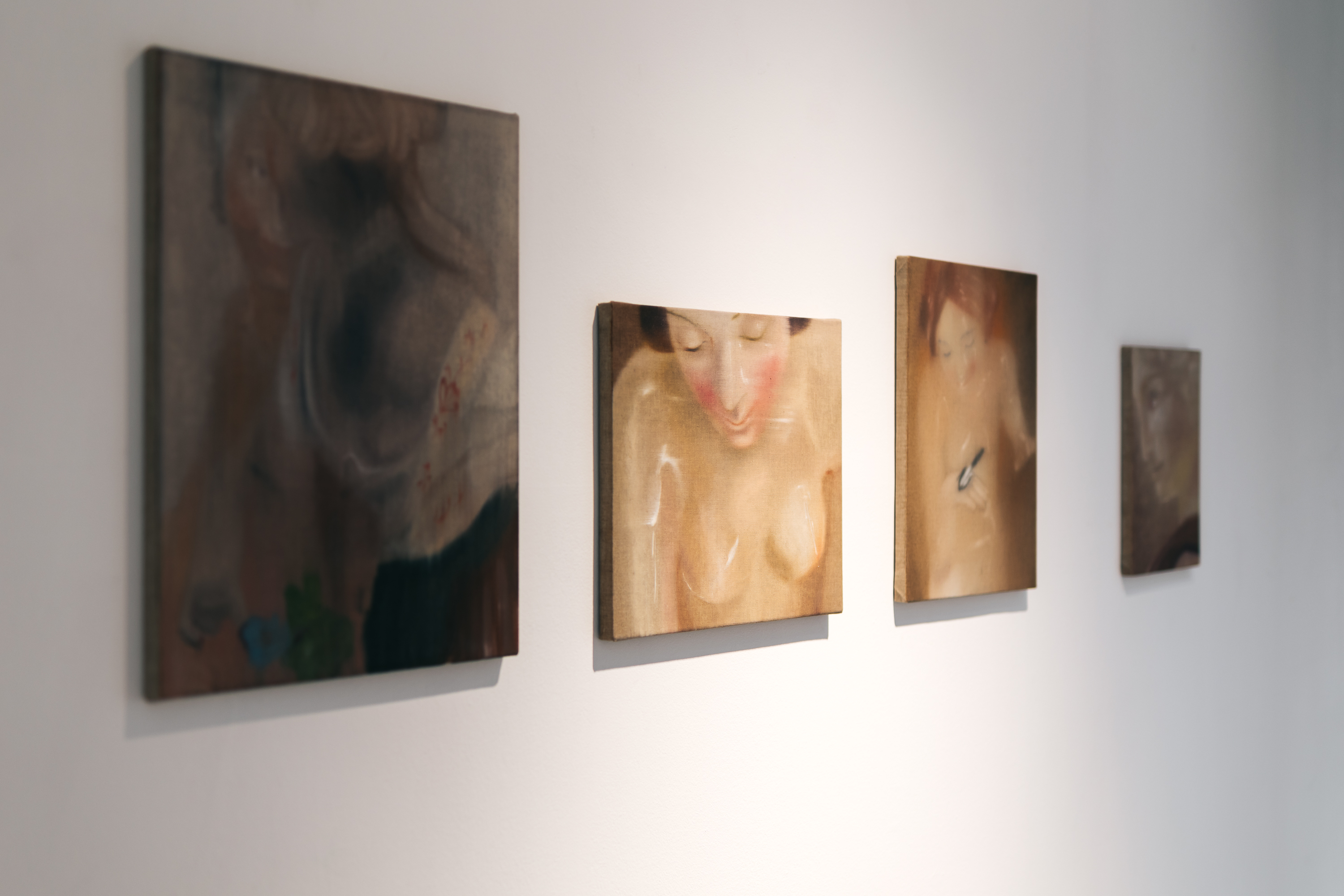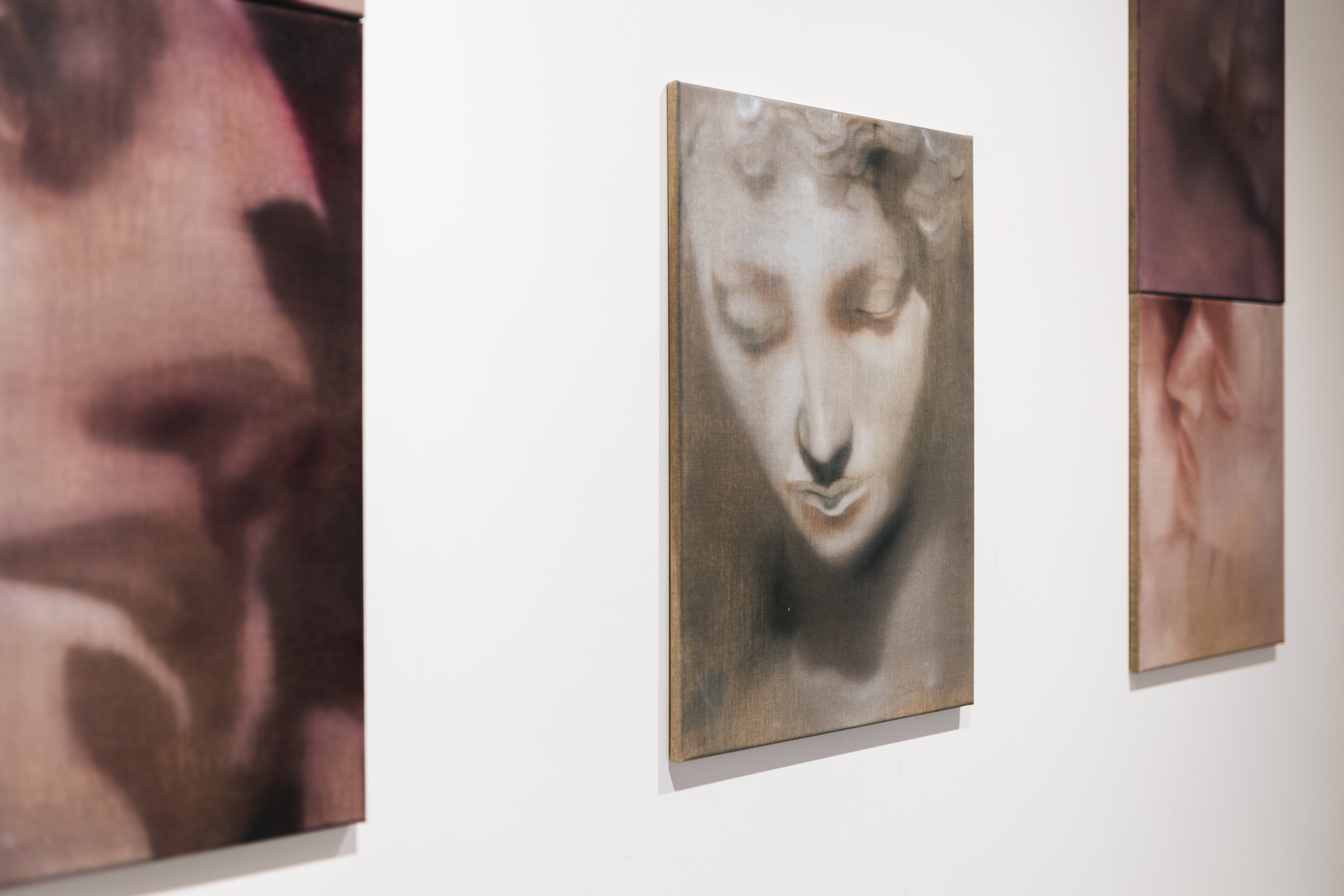About
Agnieszka Apoznańska
That night I dreamed in pink
13.04 - 18.05.2024
curator: Bogusław Deptuła
Frames, close-ups, cuts - sensual, yes, sort of, but not really. However, there is something cool, statuesque, disembodied about them. It's hard to say what, but it's certainly not normal eroticism. The gazes caught in the frames are rather dead, the eyes untrue, disturbing.
The artist seems to paint a kind of seen "sex life of Meissen porcelain" in her recent paintings. Viewed and shown well, it can be truly sensual. It seems that the painter manages to bring out the eroticism in these rather conventional porcelain figures.
She says the characters in her earlier paintings have grown up a bit, and maybe even grown up, so they are beginning to enter the erotic age. A doll, a figurine, a toy - they can replace real people, real human characters. At the same time, this peculiar costume, not to say disguise, make any messages involving them more metaphorical, universal, avoiding the literal or mundane.
A porcelain figurine can not be debauched or licentious! And for a long time it was so... These mini sculptures, of course, lived their hidden and inauthentic erotic life, but they always carried this erotic potential. They were perverse, but not personally, but metaphorically, not tactilely, not all over, as if through a glass. The shiny figures and the matte surface of the paintings, the transformation of vision, the change of impression - I like this procedure.
Eighteenth-century Meissen originals were gorgeous - because that's what they were supposed to be. Shepherdesses, young men, dancing peasants, peasant girls, kids, Beltarms and Colombines, sheep and goats. The falsified world of the Arcadian idyll, artificiality, falsity and cuteness. It looks worse in the mass fake production of the 19th and 20th centuries, and it's rather the later ones that appear in Apoznańska's paintings.
Does it matter at all? Probably the least! Figurines are figurines, but encapsulated in them is this non-obvious emancipatory ethos. In Apoznańska's previous paintings they were beautiful and mindless, now they are gaining awareness, probably even self-awareness. They seem to undergo an emancipation process: the Colombines become women, the shepherdesses become girls, their world becomes real.
Apoznańska is both tender and cruel. She admires and condemns - at the same time. She brings her heroines and heroes to life so that she can observe them, analyze them. She watches compassionately, a bit like a biologist curious about a particular new case. And she has the right to do so, because all these figures came out from under her brush.
These are not epic stories, they are rather intimate, tender tales. But I admit that there is a transformative, maturing, emancipating power in them. There is nothing wrong with sex - really, if it is consensual for both parties. And maybe let it stay that way.
Consciousness thickens. Self-consciousness arises. This could not have been predicted. Somewhere along the way, beauty is born. These images are self-sufficient, lovely and intriguing. They encapsulate time and the figure of immutability. And perhaps let them stay that way - seductive and immaterial in their porcelain-ness. I'll look at them more closely and maybe see something else.
They are all actually pink. This color did not actually appear in Agnieszka Apoznanska's paintings before. She chose it now with deliberation and thought. Pink is an indifferent color. It can be said that it belongs to the pastel colors, which are created by adding white. At the same time, today it is even an idiomatic color of femininity, bisexuality, lesbianism, genderism. Interestingly, in the 18th century it was rather chosen and recommended for men. This completely changed after World War II, when it was taken over by girls and women, while blue was designated for men.
Paradoxically, Apoznańska chooses roses that have a cool and somewhat soiled hue. These are not the purest roses of cherry blossom petals. They are roses that are somehow pregnant, perhaps even vaginal or slightly protrusive. The roses are not at all obvious, matte roses, because this series of paintings is largely painted directly on gray canvas without a white backing. The gray of the canvas absorbs some of the color and takes away the luster.
This dullness also gives it validity, changes it, shades it. So everything becomes even more enigmatic, ephemeral, ambiguous. The love affair with the rose brought a rather unexpected painting effect and changed the contexts of pinkness.
The title of this text and the entire exhibition comes from one of Agnieszka Apoznanska's paintings.
Display

















